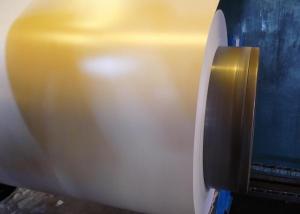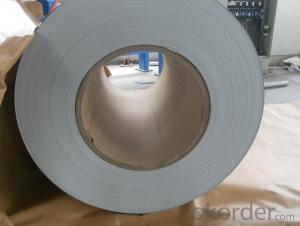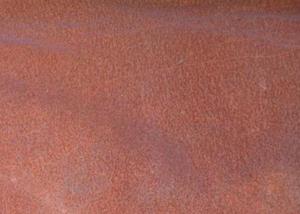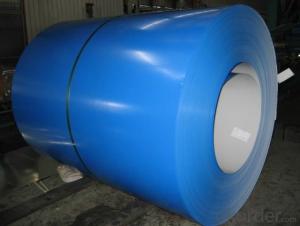Pre-painted Galvanized Steel Coil
- Loading Port:
- China Main Port
- Payment Terms:
- TT OR LC
- Min Order Qty:
- -
- Supply Capability:
- -
OKorder Service Pledge
OKorder Financial Service
You Might Also Like
Galvanized steel coils base metal as ASTM 653A, G 30, Commercial quality, color normal white (9016 / 9003). (Refer to the sample provided for 0.30 and 0.32).
Top coat: 5mic primer + 12-15mic top coat (RMP)
Back coat: grey - 5-7MIC service coating
Dimensions & qty:
0.30*1219mm
0.32*1219mm
Packing & Shipping terms:
Container shipment. Eye to wall on wooden pallets with cardboard sleeves inside the coils. Sleeve thickness: 13—20mm. Straight winding (zero stagger).
Inner & outer bore protection to protect the coil edges
Maximum container load: around 21 MT,
Coil weight RANGE :5-7MT, COIL ID: 508MM
Guarantee for no scratches /and peeling off during roll forming process
No surface defects like paint starvation, paint cratering, paint skipping / non coated spots, burnt portions, no cross / surface dents.
Guarantee for no white rust, no edge damage, no edge waviness, no strip holes, no pitting /pin holes, no edge buildup due to zinc edge overacting, no drossing & cross dents.
PPGI coils must confirm the below mentioned mechanical properties like:
T Bend: 0T—3T
Reverse impact: 16J
Pencil hardness: H—2H
MEK double rub: >50
- Q: I am a beginner (never played before!) and I am going to try to teach myself since I think it is a lovely instrument. I am fourteen-years-old so I am not 'adult-size', haha. Anyway, what is difference between nylon strings and steel strings?Thanks :)
- Small guitars easier to find in classical range. I assume their must be small steel strings but not seen them.
- Q: So I'm trying to decide which is better. I've always had aluminum on my 6 yr old tb gelding as I do hunters on him. He's never had steel on but I've recently moved and the shoer here is more expensive. So is aluminum really worth the extra cash to keep him light on his feet or is steel really not that much different?
- Shoes don't keep a horse light on their feet, good riding does. Aluminum bends really easily and will scratch and ruin quickly. That's why you have to have your horse shod more often with aluminum. Steel is worth it. They last longer. Personally though I think barefoot is the best option.
- Q: What is the major disadvantage of hardened steel? Do you think this form of iron would be wear resistant and retain a sharpened edge?
- The major disadvantage of hardened steel is that it is very brittle unless it is tempered. Hardened steel would be wear resistant, and would hold an edge as long as you don't cut anything harder than a boiled egg - the impact of the knife on a cutting board would shatter it.
- Q: Can steel coils be customized in terms of size and thickness?
- Yes, steel coils can be customized in terms of size and thickness. Manufacturers can produce steel coils in various dimensions and thicknesses to meet specific requirements and applications.
- Q: How are steel coils inspected for color consistency?
- Steel coils are inspected for color consistency through visual inspection by trained personnel. They compare the color of the coils against a color standard to ensure uniformity and consistency across the entire batch.
- Q: What are the different surface treatments for steel coils?
- Steel coils can undergo various surface treatments to achieve different outcomes and applications. Some commonly used treatments include: 1. Hot-dip galvanizing: Steel coils are immersed in molten zinc, which forms a protective layer on the surface. This treatment provides excellent corrosion resistance for outdoor use. 2. Electro-galvanizing: A thin layer of zinc is electroplated onto the steel coils. It offers good corrosion resistance and is suitable for indoor applications. 3. Powder coating: Dry powder is applied to the surface and heated to form a durable coating. It provides excellent corrosion resistance and comes in different colors and finishes. 4. Paint coating: Steel coils can be coated with liquid paint, offering both corrosion resistance and aesthetic appeal. The thickness and finish can be customized according to the desired look and level of protection. 5. Phosphating: Steel coils are immersed in a phosphate solution, creating a thin layer that enhances paint adhesion and improves corrosion resistance. 6. Chromate conversion coating: Steel coils are immersed in a solution containing chromium salts, providing excellent corrosion resistance and acting as a primer for subsequent paint or powder coating. 7. Zinc-nickel plating: A layer of zinc-nickel alloy is electroplated onto the steel coils, offering superior corrosion resistance compared to pure zinc plating and is suitable for demanding environments. These are just a few examples of the many available surface treatments for steel coils. The choice depends on factors such as application, desired corrosion resistance, aesthetic requirements, and budget. It is important to carefully consider project needs and consult with experts to determine the most suitable treatment.
- Q: I just want regular steel, not stainless steel.
- If it rusts, magnetic, hard, heavy with high melting point I reckon yourve found mild steel.
- Q: How are steel coils inspected for width variations?
- Steel coils are inspected for width variations by using a non-contact laser measurement system. This system measures the width of the coil at various points along its length, ensuring that it meets the required specifications.
- Q: Hi, does anyone know where i can find more about this topic ? fire resistant steels for structural applications. thanks
- There is a chemical that is used presently that is sprayed onto steel beams called Monocoat. Its a form of insulation that gives steel protection for up to 2 hours I think. Hope that helps!
Send your message to us
Pre-painted Galvanized Steel Coil
- Loading Port:
- China Main Port
- Payment Terms:
- TT OR LC
- Min Order Qty:
- -
- Supply Capability:
- -
OKorder Service Pledge
OKorder Financial Service
Similar products
Hot products
Hot Searches
Related keywords




























